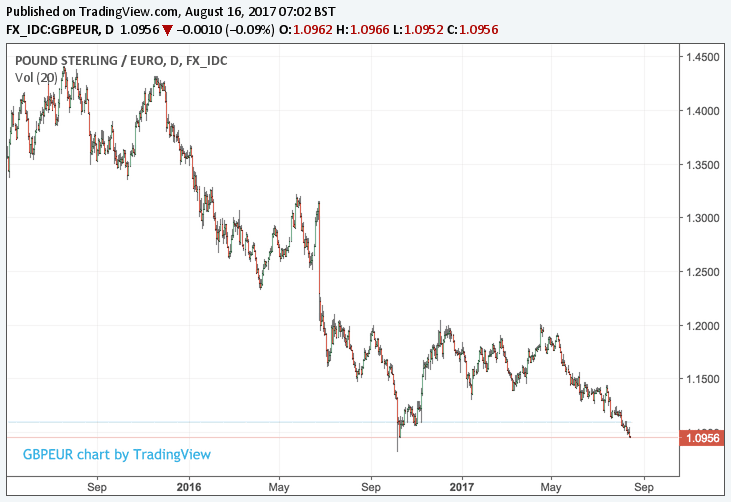GBP/EUR Rate on Bumpy Ride to 1.0 say City Index as they Join the Parity Party

City Index - the London-based brokerage and trading provider - have confirmed they see the British Pound’s decline extending and join those holding the view that GBP/EUR could hit a 1:1 exchange rate at the turn of the year.
City Index join big institutional names HSBC Holdings and Morgan Stanley being. Morgan Stanley have most recently downgraded expectations for the GBP/EUR largely on the view that the Euro is set to benefit massively as global investors buy into the Eurozone recovery story over coming months.
“The capital flows theme is the key driver of EUR/GBP in our view. Earlier on Tuesday, EUR/GBP reached its highest level since October 2016 before it gave back some recent gains,” says analyst Kathleen Brooks at City Index. “As this pair moves towards 1.00 we expect some setbacks, but we also expect most of these to be technical – options expiries, positioning etc.”
The capital flow story is by extension also one for Sterling; “right now the UK is not an attractive destination for the world’s capital.”
A survey from Bank of America Merrill Lynch said that “Anglo Saxon political angst” is spurring a shift in investment away from UK and US equities in to Europe. As we report here, Bank of America are forecasting the Pound to decline against both the Euro and US Dollar into year-end.
“Thus, political problems, namely the Brexit negotiations and the hobbled Tory party, remain a threat to the Pound as it makes the UK a less attractive investment destination, with investors choosing Europe over the UK,” says Brooks.
The analyst's technical studies - i.e. studies of historical charts with the view of getting insights into potential future moves - are also advocating for declines.
“The structural trend remains in place, and as Europe’s economic and political climate warms then capital flows should continue to boost the Euro at the expense of the Pound especially, and even the Dollar. Parity in EUR/GBP by year-end does not seem beyond the realm of possibility,” says Brooks.

Another technical analyst who is watching the step-by-step decline in GBP/EUR is Lucy Lillicrap with foreign exchange brokers Associated Foreign Exchange.
Lillicrap agrees with the view that the move lower is certainly not going to be uniform and is looking for support at 1.0950 to help Sterling. Ultimately though, “further deterioration remains readable going forward.”
But, Lillicrap reckons the Pound to Euro exchange rate falling to parity might be a step too far.
Rather the selling pressure might ease before then:
“In macro terms studies argue this sell-off from 1.2000 or so may well prove terminal/exhaustive so far as the much broader descending sequence in place since mid-2015 (circa 1.4400) is concerned.
“Nevertheless technical studies argue risk for an extension nearer the late 2008 historical extreme at 1.0200 will develop before exhaustion sets in once again.”
Christopher Hine, a technical analyst at Credit Suisse is not yet ready to look at parity but believes that should the Pound to Euro rate fall below 1.09 then there is a vacuum that will not be filled until 1.0630.
This technical target marries with the fundamental forecasts held by Credit Suisse that suggests the GBP/EUR exchange rate is likely to fall to 1.06, but over the course of the next 12 months.
Whether the GBP/EUR is at 1.0 or 1.02, those with international payments or holiday money purchases will have to get used to the idea of exchanging at levels below parity owing to the wide spreads charged by their banks.
However, we would point out that in all cases huge savings can be realised by using an independent FX specialist; they can sometimes deliver up to 5% more currency than can banks.
UK Employment Data: Could Spoil the Parity Party
Standing in the way of a decline in GBP/EUR to 1.0 is the UK economy, which some suspect of being in a better state than many analysts believe.
"In contrast to a number of other forecasters who have suggested that the Pound could reach parity with the Euro before the end of the year, we think that there are a number of reasons for the Pound to reverse some of its recent losses against the Euro," says Paul Hollingsworth, UK Economist at Capital Economics.
One of those reasons is the robust economy; a point driven home by the August labour market report from the ONS which revealed the unemployment rate had fallen, the claimant count had fallen and wages had risen.
The unemployment rate dropped further to 4.4%, from 4.5%, the lowest level since 1975, but the good news doesn’t stop there. The economy is also producing job growth at a healthy clip, job creation in the 3-months to June rose by 125k, expectations were for a 97k gain.
Wages rose with average weekly wage growth up 2.1% for June, and May’s figure was also revised up to 1.9% from 1.8%.
The UK economy might have finally found the point where falling unemployment starts to drive up wages which could in turn prompt a rate rise at the Bank of England.
If this is the case, Capital Economics warn the bears that the Pound to Euro exchange rate could actually rise towards 1.14 where they expect it to end the year.
Undaunted by the good data, Brooks says any recovery in the Pound is likely to be temporary:
"We expect this pair to eventually get to parity, price action like we have seen today is a sign that it may not get there in a straight line."




